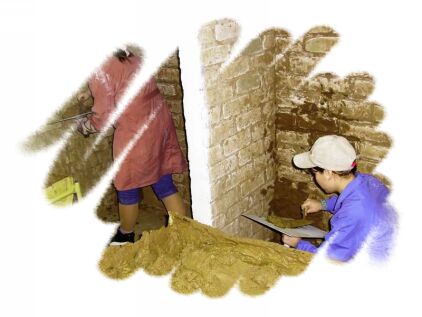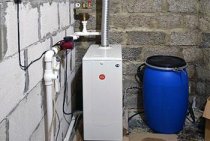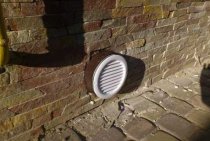The use of clay in construction
Date 03/12/2012
Author By ipadminka
Category Building materials

In order to determine the quality and suitability of clay on a plot of land or in a nearby quarry, it is necessary to conduct experimental tests of raw materials.
Fill a bucket with 2 kg of soil to be tested. Add 7-8 liters of water to the bucket. Mix thoroughly and leave overnight. The soil softens under the influence of water. The sand is separated from the silty loam. The next day, the soil with water must again be stirred. Only this time the muddy water with silty loam is immediately drained. In this case, only sand and clay should remain at the bottom of the bucket. The mixture may be somewhat clogged with small pebbles.
Weigh the sediment. The difference between the initial mass and the final one turns out to be impurities. As a result, you can quite accurately (+/- 3%) determine the percentage of clay.
Silty loam is elutriated at the construction site using a similar method. Get a couple of boxes. One box is installed at the level of the bottom of the second. The fifth part of the upper box must be covered with clay soil taken out of the pit. Then add three volumes of water. The soil must be thoroughly mixed with water. Then leave for a day. The next day, the solution in the box must be thoroughly mixed again and the water with the silty loam dissolved in it should be lowered into the lower box. To prevent sand and gravel from getting into the bottom box, the hole must be covered with a dense mesh. From the inside, at the bottom, a rail 4 cm wide is placed. The rail will contain heavy particles. In the lower box, the solution is kept for a day. We must wait for the silt to settle. Water drains, and silty loam will remain at the bottom. In order to carefully release the upper water, in the second (lower) box it is necessary to equip a shutter from horizontal rails. The seams between the shutter are rubbed with clay. Releasing water, it is necessary to remove gradually one rail after another.
You can save up to 50% of the binder when arranging thermal insulation due to the use of silty loam. If silty loam is added to clay concrete, it will be stronger. In addition, such concrete perfectly retains its shape.
During the classes
1) Organizational moment. Emotional mood.
2) Conversation. Topic message.
What do you know about sand and clay?
- Where they are used.
Repetition of the material covered on the topic "How rocks collapse"
- Why are sand and clay "children" of granite, glass and cup - his own "grandchildren"?
Conclusion: sand and clay are decay products of granite.
Emotional mood.
– Today, for a while, we will all imagine ourselves together in a modern scientific laboratory. We have to conduct a difficult, but interesting study.
Dictionary work.
- open the researcher's dictionary and remember what a laboratory is. (laboratory is a room where research and experiments are carried out).
– And what is experience (Experience is a test of some assumption (hypothesis) in practice. It is more interesting and better to conduct experiments yourself, with your own hands, and not watch how others do them).
What questions should every researcher ask himself? (What? How? Where? Why? Why? When? Why? And what follows from this?)
Representation of officials.
What laws do we have to follow?
- Everyone participates in the work, everyone has their own role.
- Everyone helps each other.
- Conflicts are resolved peacefully.
- When one speaks, everyone listens attentively.
Formation of new knowledge and methods of action.
Practical work. Topic: "Properties of sand and clay"
Purpose: to establish what properties minerals sand and clay have, what properties a person relies on when using them.
1) Independent work, performance of experiments, registration of results in the table.
Instruction:
Experience 1. Establishment of flowability.
Purpose: to find out that it is easier to pour sand or clay.
(conclusion: sand is more easily poured in a stream. The sand is free-flowing.
Clay does not form a stream. Clay does not flow
Experience 2. Determination of the viscosity of sand and clay.
Purpose: to find out what binds more strongly to each other - particles of sand or clay.
Mix sand and clay and make balls, sausage, kalachik.
(Conclusion: clay easily rolls into a ball. It is strong, plastic, you can make a sausage out of it, bend a ball. You can’t make a ball out of sand, you can’t make a sausage, it crumbles. Sand does not have viscosity, its particles do not adhere well to each other, clay particles are very adhere well to each other).
Experience 3. Establish the permeability of sand and clay.
Purpose: to find out what passes water better - sand or clay. Put filter paper in the funnel, and pour sand into one funnel from the top, and clay into the other. All this is inserted into an empty glass. Pour water. Observe in which glass the drops of water appeared first. Which glass will fill with water the fastest?
(Conclusion: drops from a funnel with sand appeared earlier. Water in this glass collects faster than in a funnel with clay. Sand passes water well. Clay is worse).
2) Verification of independent work. Property comparison.
| Basic properties | Sand | Clay |
| Flowability | + | — |
| Viscosity | — | + |
| Water permeability | + | — |
3) Organization of the study.
Problem: the difference between the properties of sand and clay.
Subject of research: sand and clay.
Task: to find out what is the reason for the differences in the properties of sand and clay.
Assumption:
A) the structure of the particles
B) particle size
C) the location of the particles.
Study plan:
- Let's study the appearance of sand and clay.
- Let's study the structure of sand and clay with a magnifying glass.
- Let's do a simulation.
- Let us conclude whether our assumption is correct.
Research result:
- Sand and clay are composed of individual particles, but the shape, size, distance between them are different.
- Sand consists of circles of different sizes, clay consists of small particles similar to scales, strongly bonded to each other
Modeling particles from plasticine.
Conclusion:
- Sand is poured easily, because. large rounded particles slide easily, do not touch each other. Clay is flat, small particles touch each other and interfere with spilling.
- Round sand particles do not adhere well to each other, so the sand does not have viscosity. Clay has good viscosity, tk. small flat particles stick to each other easily and firmly.
- The sand consists of more round particles, they are loosely arranged, with larger gaps between them. Water passes through them easily. There are small spaces between small, flat clay particles. Water flows poorly and slowly.
- The structure of sand and clay particles explains the features of viscosity, water permeability, and flowability. Our guess was correct.
3) Consolidation of the acquired knowledge.
Test:
- Sand;
- Clay.
Key: 1 - A, B; 2 - V.
Lesson summary:
What have you learned? What have you learned?
What was difficult (easy)? What was interesting (not interesting)? What was important?
Clay concrete and its applications, Gernot Mincke
I believe that this book should be read not only by every eco-builder, but by every builder in general, because it dispels so many myths and resolves so many ambiguities about clay as a building material! But most importantly, it is full of practical data on clay-based compositions for all occasions (waterproofing, water-repellent and vapor-permeable, antibacterial, insulating, etc.), and all this is accompanied by tables, figures, graphs and - attention - comparison with traditional materials like concrete, baked bricks and wood.It is especially valuable that the book is not from the category of rumors and conjectures (“one grandmother said”), but a monograph by the founder and head of the German research laboratory FEB, the experimental data of which are referred to by all well-known eco-builders
The laboratory was founded already in 1974, and during its existence a lot of work has been done in the field of the development of technologies for building from clay-based materials, projects of earthen houses have been developed, which were built not only in Germany, but also in Hungary, Russia, Switzerland, Guatemala, Ecuador, Bolivia, Chile and India
It is especially valuable that the book is not from the category of rumors and conjectures (“one grandmother said”), but a monograph by the founder and head of the German research laboratory FEB, whose experimental data are referred to by all well-known eco-builders. The laboratory was founded already in 1974, and during its existence a lot of work has been done in the field of the development of technologies for building from clay-based materials, projects of earthen houses have been developed, which were built not only in Germany, but also in Hungary, Russia, Switzerland, Guatemala, Ecuador, Bolivia, Chile and India.
In short, the source, to put it mildly, is trustworthy. And he writes the following. I will quote with some abbreviations and corrections (corrections due to abbreviations 🙂). Explanations in brackets are mine. Let's start with the drawbacks:
In this list of pluses, we can safely add that it is simply pleasant to work with clay, and the hands after it are as soft as a baby's bottom. The construction process itself brings back to childhood: which of us did not like to do in the mud? And it also awakens creativity, because from clay, like from plasticine, you can sculpt any shape: even statues, even furniture, even a bath or sink - there is also a book about this.
The above snippet is just a small part. In addition to compositions with clay, the book shows different methods of construction: monolith, from raw bricks, from raw blocks of various configurations, with and without formwork. Moreover, the tools used (both manual and electric) are given for each method, examples of mechanization and optimization of construction are given. Information is also provided on the use of clay for waterproofing the bottom of reservoirs: pools, ponds, lakes.
In my opinion, if you are already interested in this blog, then you will not be able to pass by such a book. Download link: Gernot Mincke, Clay Concrete and Its Applications (read online, download).
Now, if you have acquaintances who are skeptics or simply doubt clay as a building material, you have arguments. Feel free to send them to either read this article or read the book itself. Sharing is easy, use the buttons below.

